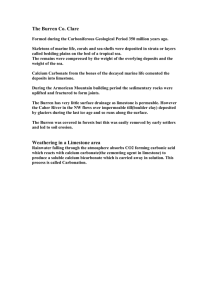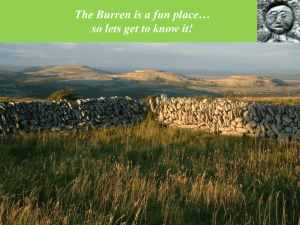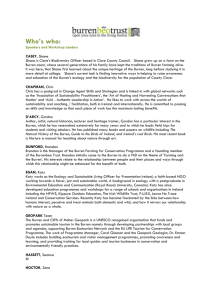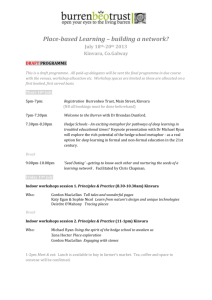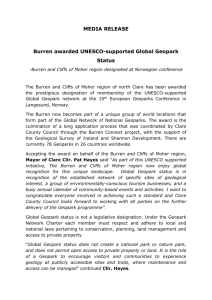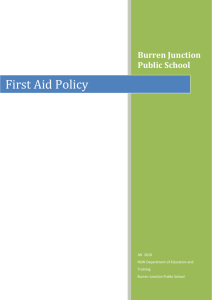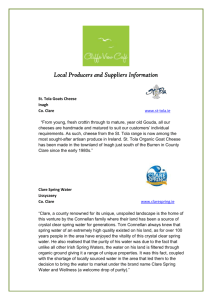Farming for Conservation in the Burren
advertisement
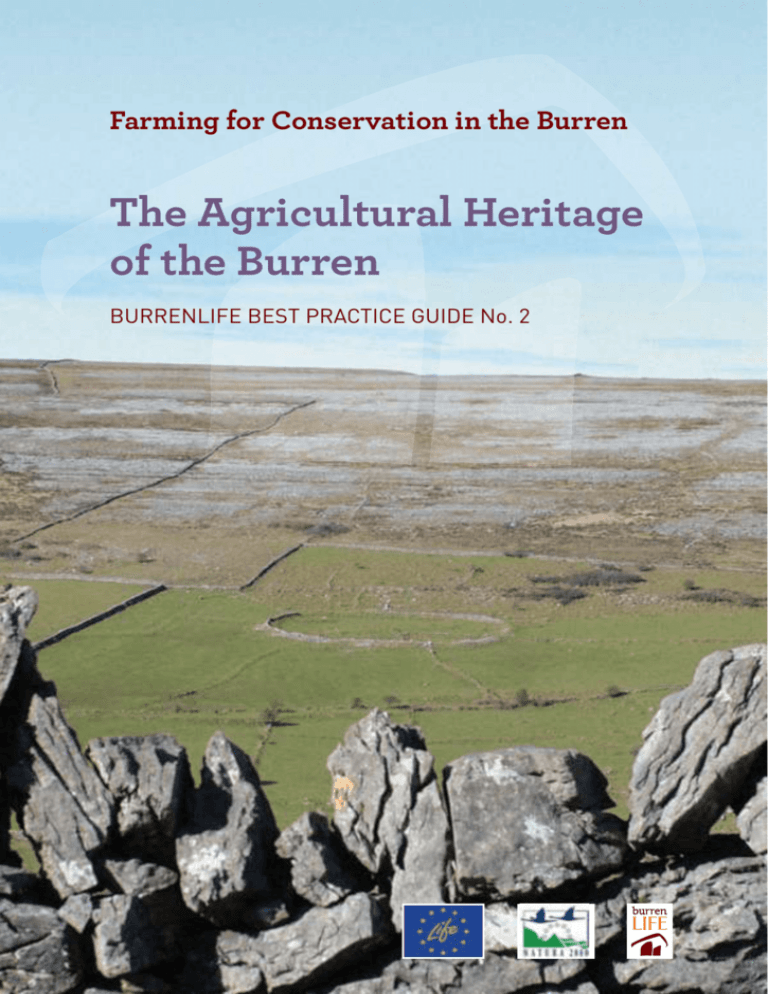
Farming for Conservation in the Burren The Agricultural Heritage of the Burren BURRENLIFE BEST PRACTICE GUIDE No. 2 The BurrenLIFE Project The Burren, also known as An Bhoireann - the ‘place of stone’- and described by Cistercian monks as the ‘fertile rock’, is a unique and very special place. It is one of Ireland’s most outstanding landscapes: a place of great beauty and fascination, steeped in history, teeming with wildlife and blessed with a rich culture and strong sense of community. For some the Burren is a home, for others a place to visit, to study or simply to enjoy. But the importance of the Burren extends far beyond its borders – its heritage is of outstanding universal value. This value has been recognized at European level by the designation of much of the area as Natura 2000 Sites, or Special Areas of Conservation (SACs), under the EU Habitats Directive. As such we are obliged to manage the Burren in such a way that future generations from near and far can continue to benefit from it. The Burren as it may have looked to the first farmers almost 6,000 years ago. INTRODUCTION To look after the Burren properly we must appreciate that the Burren has been shaped, not just by natural forces, but by countless generations of farmers as well. The BurrenLIFE Project has worked closely with Burren farmers and other experts to create a blueprint for farming in the Burren, through which farmers can earn a decent living from the land and continue their longstanding role as producers of quality food and custodians of a magnificent heritage and landscape. The information contained in these guides is based on five years of applied research which took place on 20 farms across the Burren. The practical, locally-targeted solutions contained herein have been tried and tested by Burren farmers on their land and closely monitored by the project team. The BurrenLIFE Project was co-ordinated by the National Parks and Wildlife Service (NPWS) of the Department of the Environment, Heritage and Local Government. It was a close partnership between the NPWS, Teagasc and the Burren IFA. The Project was part funded by the EU LIFE Nature Fund. NPWS wishes to acknowledge the strong support provided by Teagasc, the Burren IFA and the Burren farmers for this Project. © BurrenLIFE Project 2010 While the heritage value of the Burren - natural and built - is widely recognised and valued, the relationship between this heritage and the people of the Burren is often overlooked. The Burren is not a museum or a wilderness: it is a living landscape which is shaped by human presence and threatened by human excess and neglect. The impact of people - particularly through farming - permeates every aspect of the Burren, a cultural landscape which reflects the combined works of nature and man. An Bhoireann - place of stone - would have looked very different to Stone Age Burren farmers 5,500 years ago: it was a lightly wooded landscape dominated by pine and hazel. Pollen and archaeological records suggest that clearance of areas of woodland for cultivation and grazing led to a more open landscape which was later subject to extensive soil erosion, thus exposing the rocky limestone bedrock skeleton. Today this ice-sculpted (‘glaciated’), water-worn (‘karst’) geology is world famous. The impact of farming is also seen in the built heritage. The iconic Poulnabrone portal tomb was built by Stone Age Burren farmers over 5,000 years ago. Later generations of farmers built ‘wedge tombs’ and cist graves to bury their dead, magnificent stone forts to protect their stock and layer upon layer of stone wall to divide and define their land holdings. This rich history in stone amounts to a very intact record of thousands of years of human struggle and is aptly described as ‘one vast memorial to bygone cultures’. Even the flowers of the Burren - and the wildlife of the region - have a close relationship with farming. The ancient practice of low-input winter grazing has been shown to be a critical factor in the maintenance of some of Ireland’s most rare and valuable grassland habitats and plants, which themselves support an unparalleled array of insect life including butterflies, moths, bees and beetles. But there is also an ‘unseen’ or ‘intangible’ heritage for which the Burren is valued. This rich tapestry of music and folklore, poetry and prose, wisdom and wonder, has been passed down through generations and continues to be added to. The story of farming itself - beautifully captured in the legend of the Glas Ghoibhneach - is one of the most compelling aspects of this ongoing narrative of a people and their place. The BurrenLIFE project works with the local farming community to help protect the rich agricultural heritage of the Burren and its custodians, the farmers. This guide celebrates this heritage as something to be enjoyed and valued, a legacy that you as a farmer must look after for future generations. 1 READING THE LANDSCAPE - PLACE OF STONE, SHAPED BY WATER “Of this barony it is said that it is a country where there is not water enough to drown a man, wood enough to hang one, nor earth enough to bury them. This last is so scarce that the inhabitants steal it from one another and yet their cattle are very fat. The grass grows in tufts of earth of two or three foot square which lies between the limestone rocks and is very sweet and nourishing.” The Burren has many caves, some containing important geological and archaeological features. Ludlow, 1651 From left to right: The Burren limestone is very rich in fossils - the remains of marine life of 300m years ago; Kamenitza are an example of karren (small solutional) features, formed by the corrosive action of acidic rainwater on limestone; Runnels are another common karren feature, formed by acidic rainwater running down the side of the limestone rock. Limestone pavement, a ‘priority’ habitat. Most pavements are composed of blocks of limestone (clints) separated by linear crevices (grikes or scailps). The main set of grikes in the Burren run in a North-South direction. These are characteristic karst (solutional) features. Turloughs are seasonal water bodies found in limestone areas. They rise and fall depending on the level of the water table. This swallow hole is the route through which the turlough fills and empties. 2 A glacial erratic. These distinctive limestone or granite boulders were transported and rounded by glaciers, then deposited upon melting, over 10,000 years ago. 3 ONE VAST MEMORIAL “It is a reproach to us, as a nation, that we treat these priceless ruins as mere valueless jetsam of the sea of time. We make the forts our quarries and cattle-pens, the cromlechs [tombs] our hovels and pig-styes.” Westropp, 1899 L-R: The small rectangular passage in this wall is known locally as a ‘puicket’ and was unblocked to allow sheep to pass through the wall; a ‘turf thuile’ thought to have been used to dry out cow pats and sods of earth as a crude form of fuel; a T-shaped shelter wall, used to protect outwintering livestock from cold winds and rain. Collectively these and other ‘forgotten’ farming structures represent a unique and very special heritage resource. A mound wall snaking across the landscape. These ancient boundaries are often overlooked but are important archaeological sites, probably over 4000 years old. L-R: A penetential station used as a site for prayer and penance. These may be found individually or in clusters; A fulacht fiadh. This horseshoe-shaped Bronze Age (c.3000 years old) site was used for cooking food and possibly for bathing and other functions. A ‘Mega-lithic’ (giant-stone) tomb, built around 4,000 years ago. Over 70 of these evocative ‘Wedge’ tombs have been found in the Burren. 4 A stone fort or ‘Caher’(see also front cover). Hundreds of these ancient farmsteads are found in the Burren, attesting to the longstanding importance of farming in the region. 5 A NATURAL WONDERLAND “The herbage, produced in those [winterages] of the best quality, is of the most nutritive kind, and plentifully intermixed with yarrow, white clover, trefoil (medicago), birds foot trefoil, and fattens a few black cattle and immense numbers of sheep, the mutton of which is amongst the best in Ireland.” The species-rich pastures of the Burren are a feast for the senses - sight, sound and smell. Teeming with wildlife, these rare habitats are protected under EU law. Dutton, 1808 The Burren’s rich flora supports a range of insect life such as the transparent Burnet moth, a red and black daytime flying moth commonly found in the Burren; The common lizard, an elusive reptile found widely in the Burren; The Irish hare - along with the fox and badger - is a common sight in the Burren. Hares are becoming increasingly rare elsewhere in Ireland. L-R: The Burren is a hotspot for lichens, mosses and fungi, so called ‘lower plants’ which are often overlooked but are an important part of the Irish flora; Mountain avens - an Arctic plant - one of the most characteristic and profuse plants of the Burren; The spring gentian is often used as a symbol for the Burren. This alpine flower blooms in April - May, heralding the summer ahead. L-R: L-R: The Burren is famous for its orchids with over 20 different species on show including the small but beautiful fly orchid; Grasses are also flowering plants. The ‘fear gorta’ or famine grass is common in the Burren, and is said to grow where people died in the famine; The Burren is a hotspot for a number of bee species which are now in decline elsewhere in Ireland and Europe. 6 The Burren hosts more than 100 species of breeding birds including spectacular birds of prey such as the peregrine falcon, the fastest animal on the planet. 7 COMMUNITY AND CULTURE “There is a world in the land, a farming world of the most sophisticated complexity and the most astute and rich memory that in the next ten years will have vanished completely. Isn’t there something wrong with either our way of life or style of education that these huge ventricles of life, of memory or of perception are not being passed on…” John O’Donoghue, 2000 Though the Burren is internationally renowned for the richness and diversity of its natural and built heritage, the often-ignored rural communities of the Burren are rich repositories of heritage in their own right. The rough, rocky, herb-rich hills and plateaus of the Burren have elicited a distinctive human response from its dwellers. This is reflected in the evolution of unique farming traditions such as winter grazing, in the rearing of ‘milk kids’ or in the history of ranchers and their herdsmen who were paid with ‘freedoms’. It is also reflected in a wonderful array of intriguing physical structures such as rainwater harvester tanks, turf thuiles, shelter walls, goat crós and herdsmen’s huts which were built with Burren stone and local craftsmanship. It is told in stories such as that of the Máire Rua, the Glas Ghoibhneach and Bóthar na Mias. In recent years the landscape of the Burren has changed profoundly, mainly to do with changes in farming and the rural economy. Gone are the small scale, low-input, mixed farm systems of old that worked with the nuances of the landscape. Most of them have been replaced with part-time, highly specialised and mechanised modern agricultural systems which impose themselves on the land. This has resulted in significant physical changes to the landscape but has also had a worrying impact on the ‘intangible’ values of the area. In particular, a lot of knowledge relating to the traditional management and use of the Burren is being eroded as recent changes in agriculture have rendered much of this knowledge functionally and economically obsolete. This hidden heritage is being lost and cannot be replaced. The knowledge and wisdom accumulated by many generations of Burren dwellers was carefully handed down between these generations as a valuable legacy. Today this legacy is dismissed as worthless by many - but is it? In years to come, archaeologists will wonder about structures such as goat crós (right) and turf thuiles and scientists will try to work out ways of best managing orchid-rich Burren pastures and turloughs. Will the traditional knowledge, tried and tested over countless generations, be there to inform them? Or will we have failed in our responsibilities to sustain this wonderful resource, this rich legacy? The choice is ours, the time is now. 8 SOME USEFUL CONTACTS BurrenLIFE Project w: www.burrenlife.com e: info@burrenlife.com t: 065 708 9000 Dept. of Agriculture and Food w: www.agriculture.gov.ie e: info@agriculture.gov.ie t: 01 607 2000 Clare County Council w: www.clarecoco.ie e: secretar@clarecoco.ie t: 065 682 1616 Galway County Council w: www.galway.ie e: secretar@galwaycoco.ie t: 091 509 000 National Parks and Wildlife Service w: www.npws.ie e: natureconservation@environ.ie t: 065 682 2711 National Monuments Service w: www.archaeology.ie e: nationalmonuments@environ.ie t: 01 888 3109 Teagasc w: www.teagasc.ie e: info@teagasc.ie t: 065 682 8676 Burren Connect Project w: www.burrenconnect.ie e: info@burren.ie t: 065 707 2295 The Burrenbeo Trust w: www.burrenbeo.com e: trust@burrenbeo.com t: 091 638 096 A kid cró or hut. These small huts are scattered all over the Burren, usually in clusters. They were used for rearing milk kids, an Easter favourite for which the Burren was once renowned. BurrenLIFE - Farming for Conservation in the Burren Old School House Carron Ennis Co. Clare T 065 708 9000 E info@burrenlife.com www.burrenlife.com
